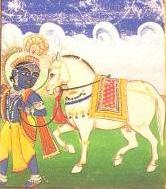This is an old revision of this page, as edited by Lenny Kaufman (talk | contribs) at 12:51, 29 November 2012 (→The Four Yugas). The present address (URL) is a permanent link to this revision, which may differ significantly from the current revision.
Revision as of 12:51, 29 November 2012 by Lenny Kaufman (talk | contribs) (→The Four Yugas)(diff) ← Previous revision | Latest revision (diff) | Newer revision → (diff)| This article may need to be rewritten to comply with Misplaced Pages's quality standards. You can help. The talk page may contain suggestions. (May 2012) |
| This article does not cite any sources. Please help improve this article by adding citations to reliable sources. Unsourced material may be challenged and removed. Find sources: "Hindu eschatology" – news · newspapers · books · scholar · JSTOR (December 2006) (Learn how and when to remove this message) |
| Part of a series on |
| Eschatology |
|---|
| Buddhist |
Christian
|
| Hindu |
Islamic— Figures —
— Events — |
Jewish
— Figures — — Events and terms — |
|
Norse— Figures and items —
— Events — |
| Taoist |
| Zoroastrian |
| Inter-religious |
In Hindu eschatology, time is cyclic, consisting of cycles or "kalpas". Each kalpa lasts 4.1 - 8.2 billion years, which is a period of one full day and night for Brahma, who in turn will live for 311 trillion, 40 billion Years. Within a kalpa there are periods of creation, preservation and decline. After this larger cycle, all of creation will contract to a singularity and then again will expand from that single point, as the ages continue in a religious fractal pattern.
The Four Yugas
Within the current kalpa, there are four yugas, or epochs, that encompass the evolution of this specific cycle. These ages encompass a beginning of complete purity to a descent into total corruption.
- Satya Yuga lasts 1.728 million years.
- Treta Yuga lasts 1.296 million years.
- Dvapara Yuga lasts 864,000 years.
- Kali Yuga lasts 432,000 years.
Kali Yuga, the last of the four ages, is the one we are in currently. This epoch has been foretold to be characterized by impiety, violence, and decay. The four pillars of dharma will be reduced to only that of charity. In addition, as the each age progresses, the human life span decreases, starting from thousands of years in the Krutha Yuga to 100 years in the current Kali Yuga.
As written in the Gita:
Yadaa Yadaa hi Dharmasya Glaanir bhavati Bhaarata
Abhyuthaanam Adharmasya Tadaatmaanam Srjaamy Aham.
Whenever there is decay of righteousness O! Bharatha
And a rise of unrighteousness then I manifest Myself!
At this time of evil, the final incarnation of Vishnu known as Kalki will appear on a white horse. The eight Adityas, or solar deities, will shine together in the sky. Kalki will amass an army to "establish righteousness upon the earth" and leave "the minds of the people as pure as crystal."
At the completion of Kali Yuga, the next epoch will begin, known as Satya Yuga in which everyone will once again be righteous with the reestablishment of dharma and piety. This, in turn, will be followed by epochs of Treta Yuga, Dwapara Yuga and again another Kali Yuga. This cycle will then repeat till the larger cycle of existence under Brahma returns to the singularity and a new universe is born.
A Chatur Yuga comprises four yuga's and lasts for 4.32 million years. A Chatur Yuga comprises the time of existence of the entire universe, after which it will contract to a singularity and be followed by a new explosion and universe.
Brahma Kumaris

Within Hinduism, there are more distinguishing scenarios in certain sects. Benjamin Beit-Hallahmi of the Brahma Kumari has written that their prediction of the imminent end of the world is hidden from non-members. Within their tradition, the majority of the planet is predicted to become submerged beneath the ocean, similar to the Ragnarök of Nordic mythology.
See also
References
- Hooper, Rev. Richard (April 20, 2011). End of Days: Predictions of the End From Ancient Sources. Sedona, AZ. p. 156.
{{cite book}}: Cite has empty unknown parameter:|coauthors=(help)CS1 maint: location missing publisher (link) - www.sanskrit.org/www/Hindu%20Primer/yugatime.html
- "Vishnu Purana". Astrojyoti.com. Retrieved 2011-11-21.
- "The Mahabharata, Book 6, Bhagavad Gita Chapter IV, Section 7". Sacred-texts.com. Nov 12, 2012. Retrieved Nov 12, 2012.
{{cite web}}: Check date values in:|date=(help) - Browne, Sylvia. End of Days: Predictions and Prophecies About the End of the World.
{{cite book}}: Cite has empty unknown parameter:|coauthors=(help) - "What Vedas say about the age of the Universe?". What Vedas say about the age of the Universe?. Gurudev. Retrieved 1 May 2007.
- Beit-hallahmi, B. (2004). "Death, Fantasy, and Religious Transformations". The Psychology of Death in Fantasy and History. Retrieved 2008-01-25.
A case study of Brahma Kumaris, a contemporary group characterized by an apocalyptic vision (kept hidden from nonmembers).
- Varughese, Suma. "An article on the sect of the Brahma Kumaris in Rajasthan, India". Lifepositive.com. Retrieved 2011-11-21.
| Philosophy |
|  | |||||||||||||||||
|---|---|---|---|---|---|---|---|---|---|---|---|---|---|---|---|---|---|---|---|
| Texts |
| ||||||||||||||||||
| Deities |
| ||||||||||||||||||
| Practices |
| ||||||||||||||||||
| Related | |||||||||||||||||||
This Hindu philosophy–related article is a stub. You can help Misplaced Pages by expanding it. |